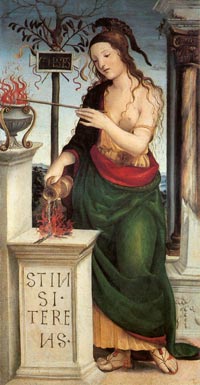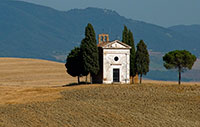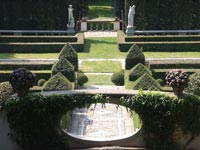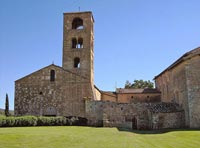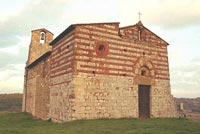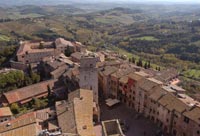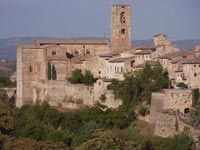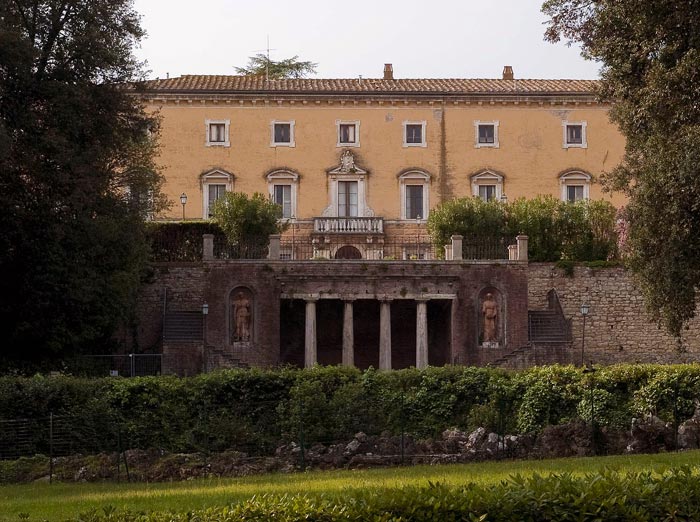 |
Villa Chigi Saracini |
Villa Chigi Saracini |
Villa Chigi Saracini has been built up on the initiative of Count Galgano Saracini who wanted a great decorum house for his family, with a large park to make the most of it. Building the new complex produced a radical alteration of the main urban order, since a big part of castle-walls was been pulled down. The complex (villa-chapel-park) has been carried out between 1820 and 1840 and is partly attributed to Agostino Fantasici. The way the park now looks like is due to Count Guido Saracini, great music lover and founder of Chigiana Music Accademy. This villa, designed in the early 19th century by its owner Galgano Saracini, stands at the entrance to the town of Castelnuovo Berardenga. Its construction led to a radical alteration of the urban layout of the town, with the demolition of the enceinte around the castle and its replacement by a retaining wall. The building, rectangular in plan, spreads over three floors, the lower portion being rusticated and the upper floors finished in plaster. The main elevations have two rounded-arch doorways, flanked by double pilaster strips terminating in corbels that support the balconies above. There is a crest on the front and the rear of the building: the one on the side facing north is that of the Chigi Della Rovere, the one on the south side is that of the Saracini Marescotti. The romantic-style park was created by Agostino Fantastici in 1834, as were the architectural features: the triple-arch bridge (designed for carriages to pass over) linking the villa to the San Quirico hill, and the Kaffeehaus. The front of the villa, where Fantastici concentrated most of his efforts, consists of a lawn with a small ornamental lake with mossy spongestone banks, opposite which the Kaffeehaus stands. This house, Neoclassical in style, divides the park from the small Italian-style garden in the area in front of the villa, which has a geometrical arrangement of box hedges and flower-beds. One side of the regularly-shaped building has four travertine Doric columns supporting an entablature, at either side of which are niches containing terracotta statues of Flora and Artemis. The building is connected to the upper garden by a double flight of steps with balustrade. The park has many types of tree and shrub, grouped together according to the different shades of green of their foliage (plane trees, beech trees, lime trees, cedars, holm-oaks and laurels). In the late 19th and early 20th centuries the park was enhanced by count Guido Saracini - a musician and the founder of the Accademia Musicale Chigiana - who introduced a series of statues dedicated to great musicians. A column was placed in the circular piazzale, or forecourt, as a monument to Michelangelo, a work by Sienese sculptor Tito Sarrocchi, who gave his name to the piazzale itself. A large twin-basin marble fountain, also designed by Sarrocchi, was installed in another forecourt that is embellished with flowers and situated between the bridge and the park's entrance gate. A small nymphaeum, semi-circular in shape, stands beneath the entrance forecourt, along the avenue leading to Sarrocchi's fountain, and is reached by a short flight of travertine steps. Another interesting feature of the park is its complex system of avenues and winding paths running up and down the hilly terrain. |
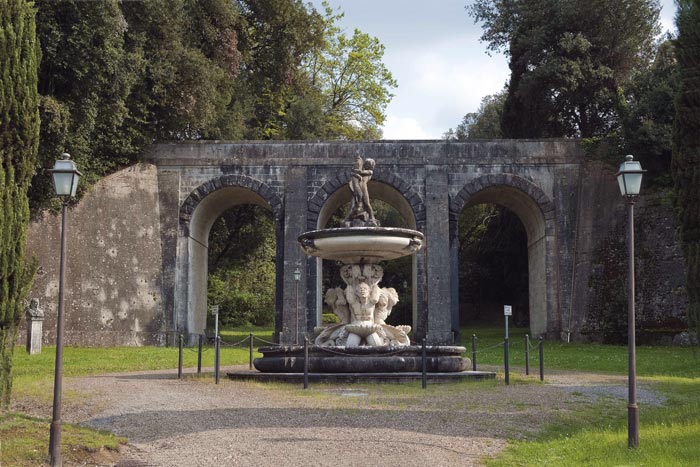 |
||
Villa Chigi Saracini, giardino |
||
Palazzo Chigi-Saracini |
||
The Chigi family was one of the most influential noble families in Rome during two distinct time frames: the renaissance and baroque periods. Before the Chigi family rose within the aristocratic ranks of Roman society, they were a prominent family in Siena. Agostino Chigi (1465–1520) was the most famous member of the family during the Renaissance. He became an immensely rich banker, and built the palace and gardens afterwards known as the Farnesina, decorated by Raphael, and was noted for the splendour of his entertainments. Pope Julius II made him practically his finance minister and gave him the privilege of quartering his own (Della Rovere) arms with those of the Chigi. Among the Medieval palazzi that line the elegant Via di Città in Siena, is the 14th century Palazzo Chigi-Saracini, currently the seat of the prestigious Accademia Musicale Chigiana founded in 1932. |
||
Story |
||
| In the mid-12th century the powerful Marescotti family, which belonged to the Ghibelline faction, erected their town house here. The imposing stone tower is still visible, along with the trifore windows in the facade of the current palazzo and the Marescotti coat of arms – an eagle with spread wings. Before the Palazzo Pubblico was built, this building was used as the seat of the Council of the Republic of Siena. Today the building is composed of two floors, the ground floor in stone and the first floor in brick, with two orders of trifore windows. In 1506 the building was bought by the Piccolomini-Mandoli family, one of the city’s oldest dynasties, who refurbished the palazzo in the new Renaissance style. In 1770 it passed to the Saracini family and by order of Marcantonio Saracini the facade was enlarged and curved in line with the street. The works started by the Saracini family only reached their conclusion in 1824 with Marcantonio’s son, Galgano, who adorned the interiors with a considerable collection of art and furniture numbering some 12,000 pieces. Galgano in fact instituted a museum within the palazzo in 1806, which was open to visitors and art students. With the extinction of the Saracini family in 1877 the building was inherited by the Chigi family. The palazzo’s last occupant, Count Guido Chigi Saracini, embarked on a fresh programme of refurbishments with the aid of the architect Arturo Viligiardi. In 1932 the Count granted part of the palazzo as the seat of the Accademia Musicale Chigiana, an international centre for advanced musical studies. The success of the Accademia was immediate and far reaching, thanks also to the contribution of musicians of considerable importance who came to Siena to help the Count with organising the academy’s courses. Among these was Alfredo Casella, who helped the Count found the academy. Today the academy can boast having taught a number of world class musicians such as Claudio Abbado, Salvatore Accardo, Carlo Maria Giulini and more. |
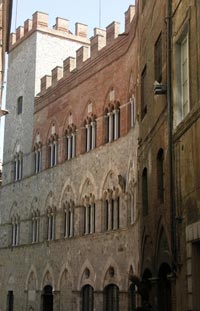 Palazzo Chigi-Saracini |
|
La Galleria Chigi-Saracini |
||
| The rococo music room of the palazzo, the Sala dei Concerti, has been hosting a prestigious winter season of concerts ever since 1923. The season takes its name from the motto of the Chigi family, Micat in Vertice. The Settimana Musicale Senese festival, which was founded in 1939, has made a sizeable contribution to the rediscovery of the music of Vivaldi over the decades. The Accademia Musicale Chigiana gained the status of a Fondazione in 1961, when it was made heir to the whole of the Count’s estate. Since the Count’s death in 1965 the Accademia has continued to flourish, thanks also to prestigious sponsors such as the Monte dei Paschi di Siena Foundation and the Banca Monte dei Paschi di Siena. The Count’s impressive art collection is still kept within the Accademia. The collection is particularly rich in Italian masters, particularly of the Senese School, such as Sassetta, Sodoma, Beccafumi, Botticelli. There are also a good deal of objects ranging from ivory to silver, porcelain and a collection of Italian ceramics from the 16th to the 18th century. The Accademia Chigiana also owns a vast literary and musical library numbering some 70,000 volumes, some of which are particularly rare. Three conditioned rooms of the Accademia are given over to the collection of musical instruments, particularly string instruments. Aldo Bennici is the current director of the academy.[1] La Galleria Chigi-Saracini Via di Città 89
(between Piazza del Campo and Piazza del Duomo
| ||
| Villa di Vicobello |
||
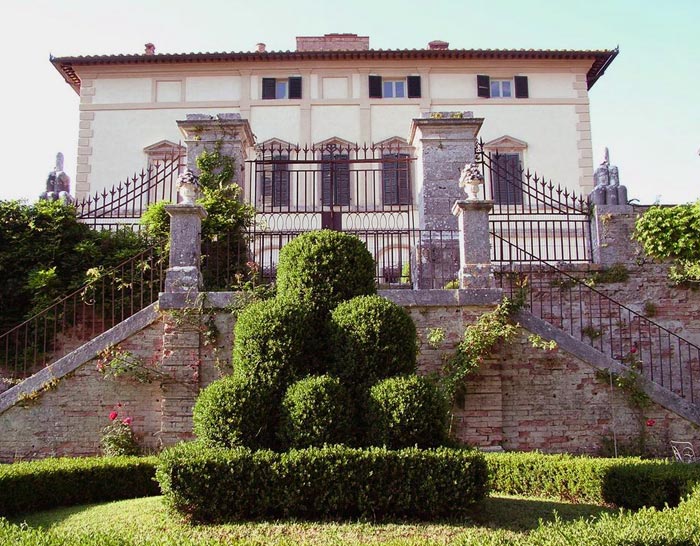 |
||
Villa di Vicobello |
||
[1] Source: www.sienaonline.com |
||
|
||
|
||||
|
||||
Podere Santa Pia |
Podere Santa Pia, view from the garden on the valley below |
Capella Vialetta, near Pienza |
||
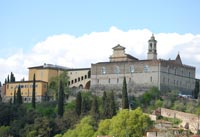 |
||||
Villa I Tatti |
Sovicille, Pieve di San Giovanni Battistaa Ponte allo Spino |
Certosa del Galluzzo (Firenze) |
||
Gardens, parks and villas in Florence |
||||
Pieve of SS. Ippolito and Cassiano |
San Gimignano, view from Rocca di Montestaffoli |
Colle di Val d'Elsa |
||

